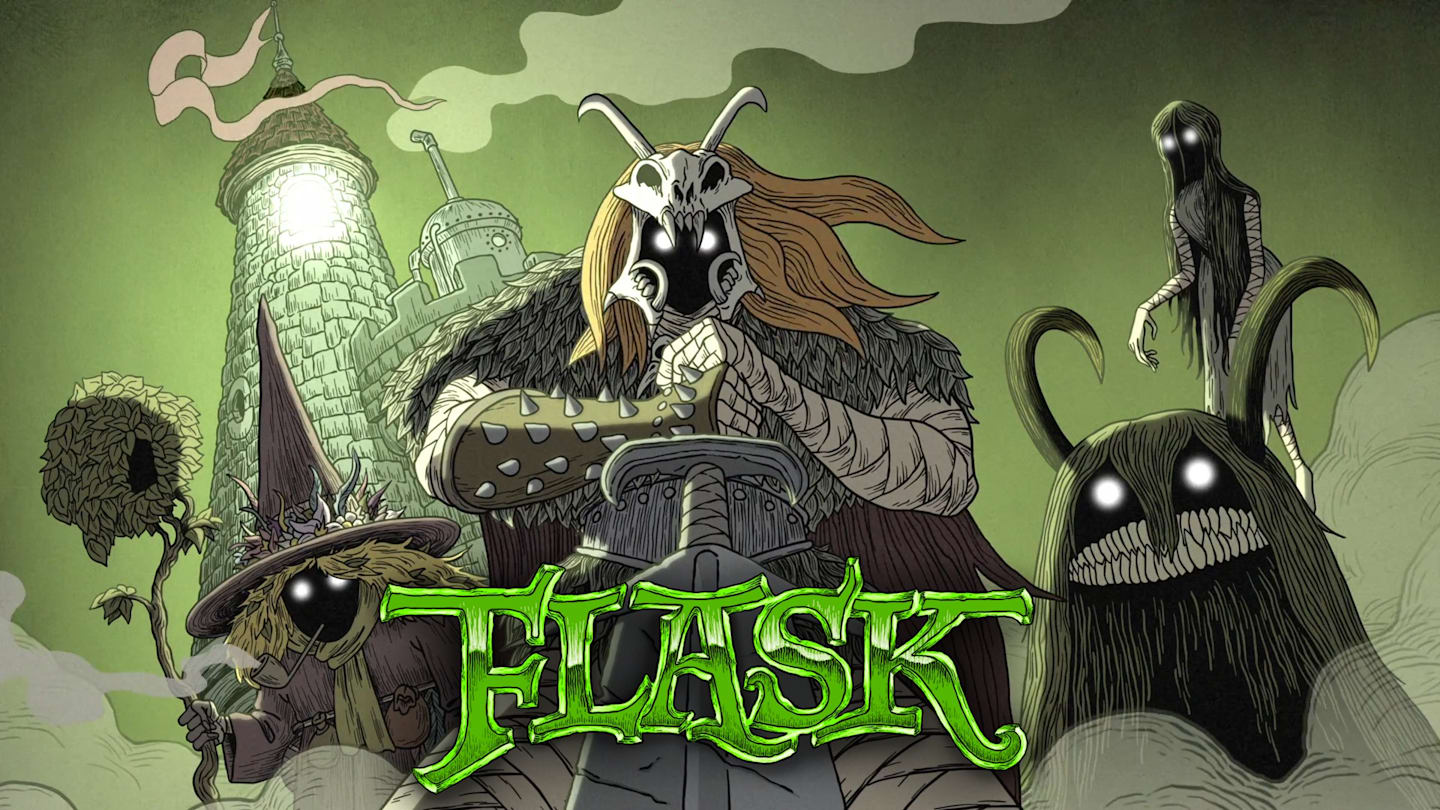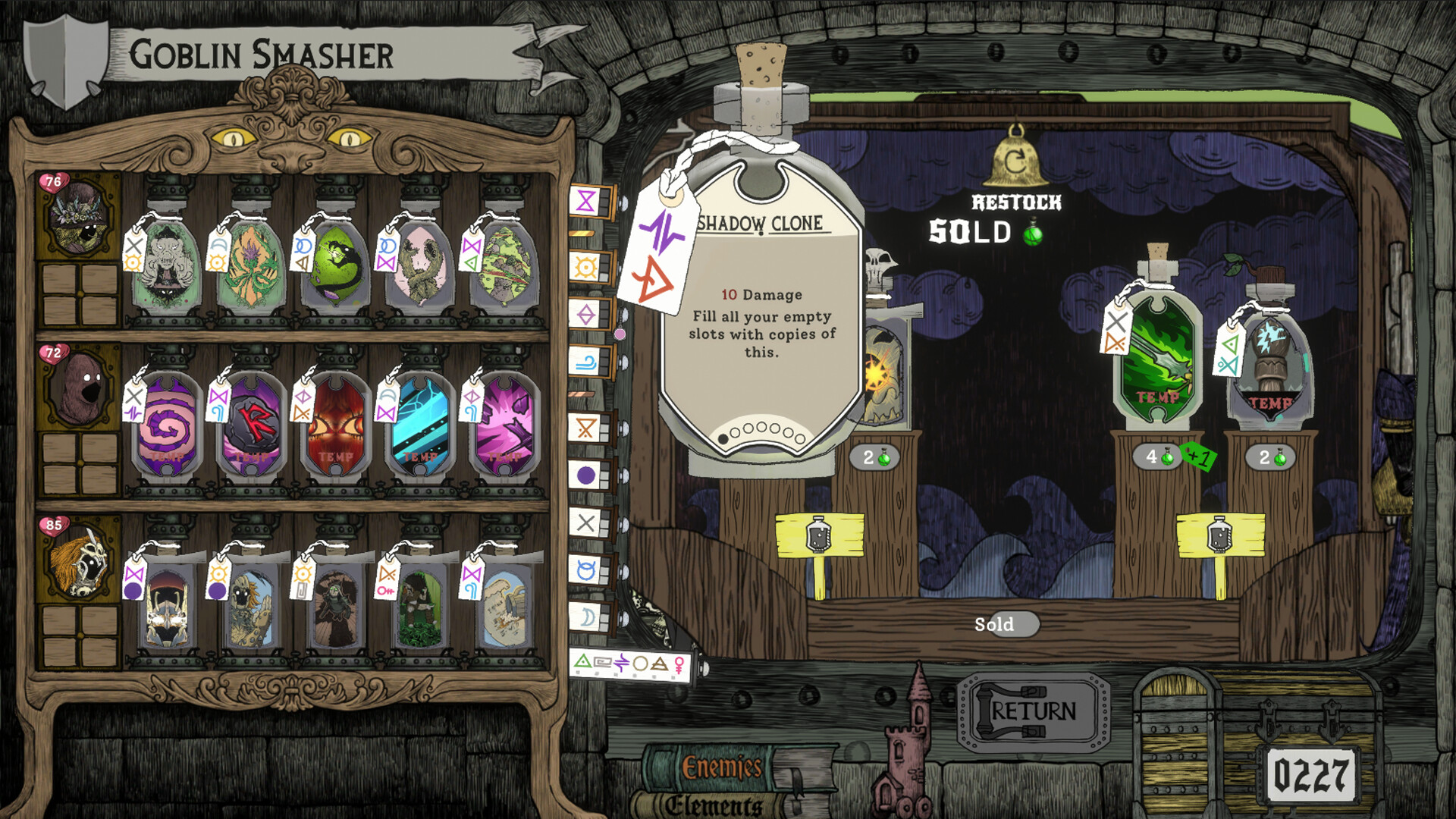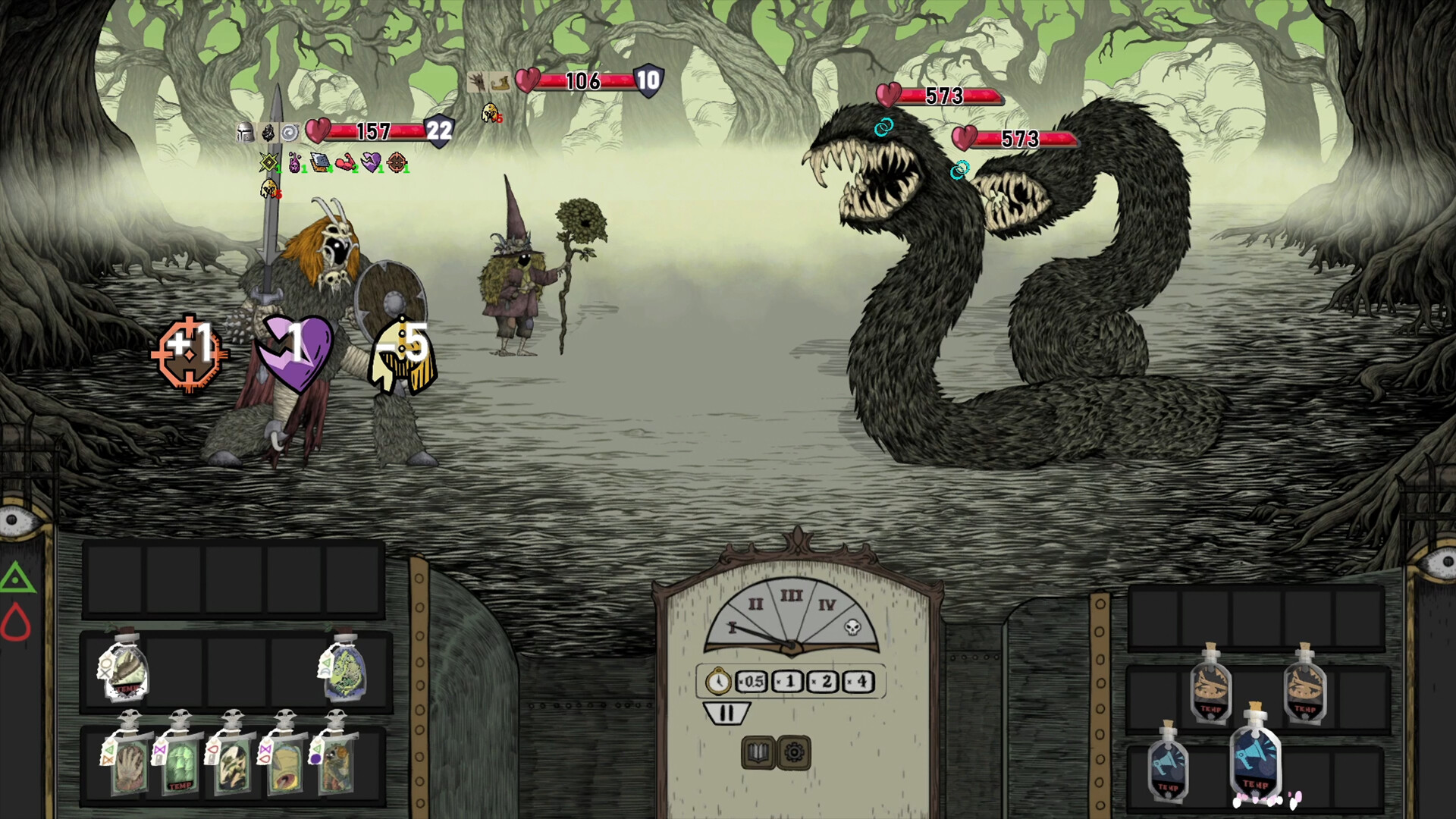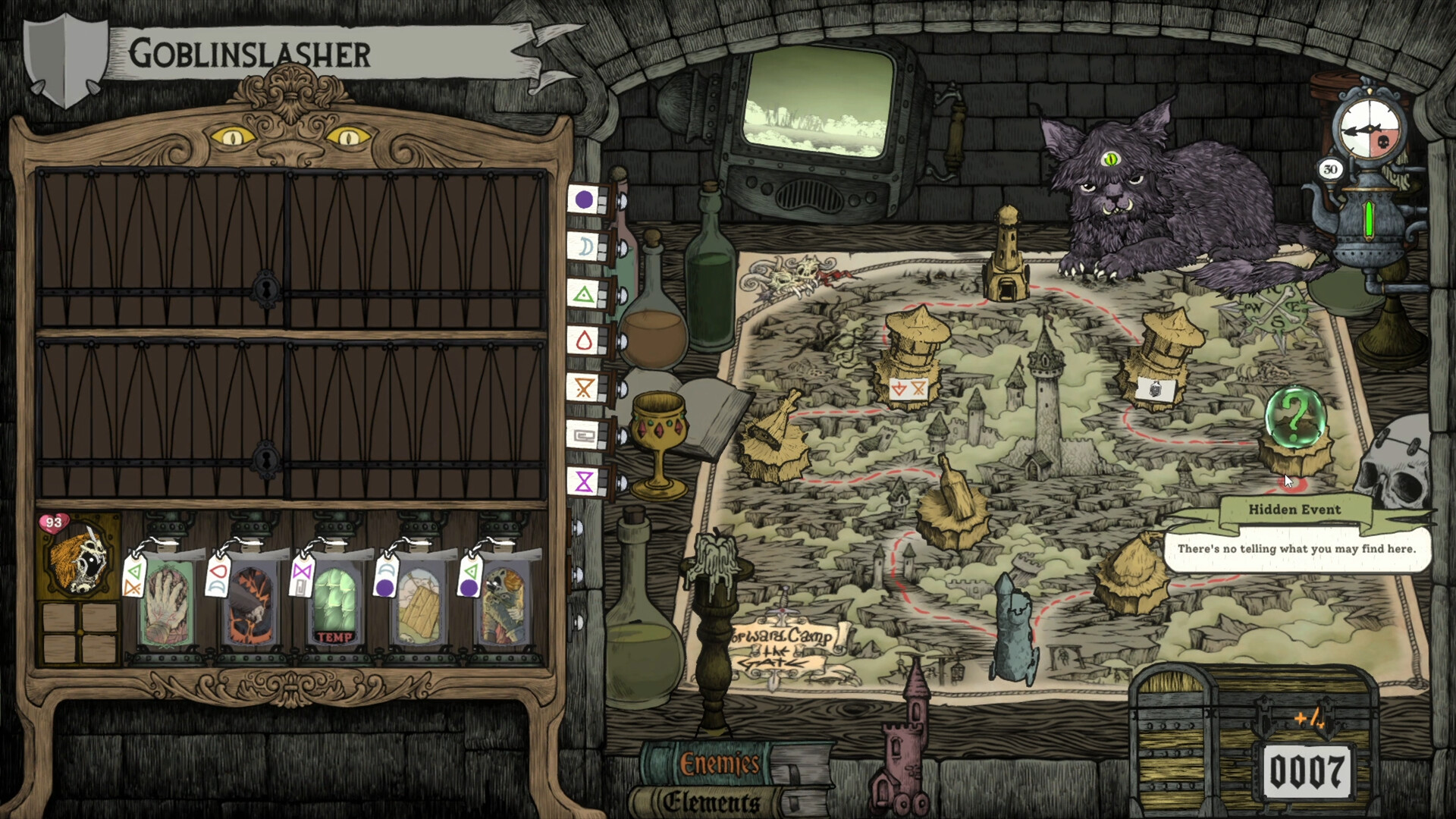
Within the broader guidelines, the roguelike deckbuilding genre serves as a significant hotbed for creativity and progression, consistently offering new, exciting twists on the formula. The forthcoming game, Flask, by Chop Chop Games, truly embodies this innovative essence.
During Gamescom 2025, I had a conversation with Dario Rahimic, Michael Kruse (both co-founders of the studio), and John Kenn Mortensen (who is the artist and narrative lead) about their then-unrevealed game.
The distinctive art style of Flask seems to leap out at you, with every detail hand-drawn by Mortensen over nearly two decades. Unlike Darkest Dungeon‘s fiery orange tones, Flask presents a backdrop of sickly, toxic green that permeates throughout, complementing the game’s characters and surroundings defined by intricate, black line art. This visual style carries an almost gritty feel, which fittingly suits its setting.
In Flask, similar to Solo Leveling, gates to different realms have opened up, filled with rare resources. Just as in that tale, these resources are highly valuable in Flask, but there’s a catch: anyone who enters the other world starts transforming and eventually succumbs to death over time. The ingenious – and let’s not forget, somewhat foolish – resolution? Scholars explore this new realm confined within portable, self-propelled towers guided by homunculi, artificial beings crafted specifically for this task.
However, since these towers come with a hefty price tag, alchemists are compelled to undertake significant risks just to settle their debts and potentially profit from their investments. It seems that for Chop Chop Games, an oppressive financial burden is what gives the world its grimdark essence.
Mortensen’s artwork breathes life into this realm, capturing its eerie yet whimsical characteristics perfectly. His background in creating comics and animated content played a significant role in achieving such an eclectic blend of tones.
According to Rahimic, it’s more about exploring uncharted lands, looting resources, combating fierce creatures, and acquiring their life essence.
Flask, much like many other deck-building roguelike games, features a world map divided into multiple paths leading to various encounters or events. As you progress along these paths, combat is a key element. However, what sets Flask apart is its unique approach to combat. Instead of traditional characters, you command Homunculi – artificial beings made of flesh. To prepare for battle, you equip these Homunculi with flasks, which serve as your cards and represent specific actions in combat. Once equipped, the Homunculi will follow pre-set routines or actions, allowing you to strategize their entire battle plan beforehand.

As a gamer, it’s clear that Flask functions like an auto-battler. Here’s the thing, since you can’t physically exit your tower, all battles are handled by the homunculi. Unfortunately, you don’t have direct control over their actions in real time.
Rahimic explains that it’s a round-by-round game. Your homunculi will take their initial potion first, followed by the enemies, and so forth. If you make it to the end, the sequence simply repeats from the start.
In Flask, since manual intervention and real-time decisions aren’t feasible during battles, the planning and decision-making processes beforehand become crucial as outcomes can be decided even before the first fight begins. A detailed combat log offers valuable insights, revealing the effectiveness of strategies when executed in reality.
With various homunculi, distinct items, modifications, and assets available to the player, there’s a vast array of possible combinations and synergies that can be created. These elements serve somewhat like categorized pieces in auto-chess: The more similar pieces you accumulate, the stronger the entire group becomes. Although each homunculus has its exclusive set of unique flasks, the elements are interchangeable and contribute to the same collective pool for overall effectiveness.
However, Flask introduces an intriguing twist: It’s not only monsters you’ll battle. Every third region will present challenges against other alchemists, where you’ll fight their homunculi. Essentially, it’s like eliminating a rival on this side of the portal, isn’t it? These battles are unique indeed. As Rahimic discloses, “The formidable bosses in this world are actually other players.” Your adversaries in these confrontations are modeled after real human players at the same stage during your adventure.

Rahimic explains, ‘We keep track of each player’s creations while they play and then pit those against others, challenging you to show your alchemist skills. To ensure fairness, we use a system to match players and remove any extremely overpowered builds.’ So, don’t fret about encountering unfairly enhanced characters.
After an encounter with a player, you move on to the next environment, which consists of seven distinct areas offering diverse monsters, occurrences, and sceneries. Every second battle against another player presents a chance to recruit their homunculus, adding a unique twist to your squad formation.
Rahimic notes that the composition of your final team can vary, so it’s important to be flexible and understand that no two runs will be identical.
He emphasizes: “In this kind of game, our focus is on drafting. Unlike auto-chess games where players may enter with a specific strategy in mind, our game requires flexibility because you don’t know what resources you’ll have. You need to be creative and strategize continually to overcome the next opponent. That’s the approach we want to encourage.
“To think on your feet,” Kruse adds.
This method also introduces novelty in other aspects, particularly focusing on the player’s strategic decision-making by consistently offering a choice between ordinary and advanced confrontations. Instead of insisting on every advanced encounter in the game for maximum efficiency, removing them as distinct points on the map streamlines your navigation strategy. However, it’s not just about practicality; it also adds depth to the game’s narrative, as choosing the riskier option can aid you in getting out of debt faster.
According to Rahimic, you have the freedom to make decisions based on your level of confidence in your creation. However, this choice can sometimes backfire. In the demonstration, Kruse decided to use several flasks that were somewhat reliant on randomness. He took a risk by employing them against an elite opponent early on, which resulted in his defeat.
Rahimic reassures, “It’s alright.” Losing for the first time doesn’t mean defeat; instead, your tower’s health depletes. You have multiple opportunities before needing to retreat with a damaged tower, since it’s best not to let your tower get corrupted by the toxic fog creeping in.

As you strategize and prepare your homunculi, your screen displays the comfortable setting of your tower, complete with a chatty three-eyed cat for company, as Mortensen explains, “Each tower includes a cat, ready to converse and exchange a few words with you.
“It’s also a spy from the Alchemist’s Guild,” Rahimic throws in. “They’re keeping an eye on you.”
The cat plays a significant role in the game’s underlying narrative as well. Mortensen, with his background in television storytelling, expresses enthusiasm for crafting nuanced tales within video games that require players to discover subtle hints scattered throughout the game.
Indeed, the game incorporates a progression mechanic that builds upon itself over time, enabling players to acquire tower enhancements or discover fresh incidents during subsequent playthroughs. However, before selecting a homunculus as their initial character, players must first encounter and hire one. The developers initially envision five homunculi, but they have plans for even more in the future.
In his own words, as an artist, it’s incredibly enjoyable for him to develop these unique characters. He finds pleasure in brainstorming ideas and presenting them to the programmers who then respond with suggestions for various alternative poses needed to create the animations.
From my perspective as an avid gamer, I’m thrilled about the developers’ upcoming addition – a ranked mode that transforms every encounter into player battles! Even though the game will incorporate other players’ builds into each run, you can still enjoy it offline. In this unique setup, the game draws the builds you encounter from a previously downloaded library.
Rahimic emphasizes that our goal is for you to enjoy playing games even when you’re mobile, similar to using a Steam Deck, all without needing an internet connection,”
Or more casually:
“What Rahimic means is, we want you to play games on the go, just like with a Steam Deck, but without requiring any internet.
Flask is targeting a release on PC in 2026.
More features on DBLTAP:
Read More
- EUR TRY PREDICTION
- UPS’s Descent in 2025: A Tale of Lost Glory
- USD PHP PREDICTION
- Arm Holdings: The AI Chip Whisperer?
- Silver Rate Forecast
- Download Minecraft Bedrock 1.23 free mobile: MCPE 2026
- The Reshoring Chronicles: Tariffs, Warehouses, and Digital Melancholy
- Oracle’s Algorithmic Odyssey and the TikTok Tempest
- AI Investing Through Dan Ives’ Lens: A Revolutionary ETF
- NextEra Energy: Powering Portfolios, Defying Odds
2025-09-09 16:18